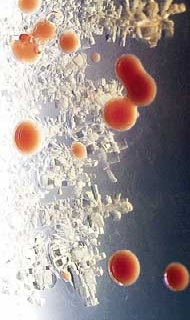One way to pass time in Antarctic extremes
 It seems gene-swapping is about all there is to do when you live in a sea of salt at negative 20 degrees.
It seems gene-swapping is about all there is to do when you live in a sea of salt at negative 20 degrees.
A team of scientists led by researchers from the University of New South Wales has discovered the genetic secrets of extremophile microbes, which can survive in conditions such as those in Antarctica’s saltiest lake.
Samples taken from Deep Lake near Davis Station have shown the promiscuous gene-swapping activities of the Lake’s residents. Extremophiles are known for their free-wheeling reproductive exchanges, but the haloarchaea may be the most liberal of all.
“Our research shows these ones swap much more genetic material with each other than has been observed in the natural environment before. Long stretches of virtually identical DNA are exchanged between different genera, not just species,” says UNSW’s Professor Rick Cavicchioli.
“Despite this rampant gene swapping, the different species are maintained and can co-exist because they have evolved to exploit different niches and consume different food sources.”
While indulging freely in each other’s genetic code, the microbes do develop their own tastes; some consume proteins in the water while others consume sugars like glycerol, from algae living on the lake surface. It is estimated the haloarchaea grow very slowly in the lake, with only about six generations produced a year.
If it all seems too academic; Professor Cavicchioli says research on extremophiles could have everyday industrial applications.
“Enzymes from cold-adapted microbes could have significant value. Their high activity in cold temperatures could provide reduced energy costs for processes that would otherwise require heating, such as cleaning, or which must be carried out at cold temperatures, such as food production or bioremediation of cold, contaminated sites.”
“This illustrates just how valuable and unique Antarctic lakes can be and why Antarctica needs to be protected so societies the world over can benefit for years to come,” he said.
The full report is accessible through the US Proceeding of the National Academy of Sciences website.








 Print
Print